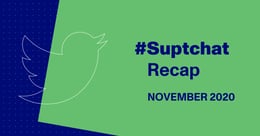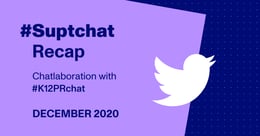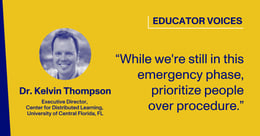
Rethinking Education Possibilities With Superintendent Tom Rooney
In 2007, the leadership team at Lindsay Unified School District (LUSD) asked the simple (yet surprisingly bold) questions: “What if our education system was centered around the needs and interests of students? What if educators met learners where they are, instead of where they think they should be?”
Some school districts have long questioned whether traditional education methods serve the interests of all students upon graduation, and whether these interests are served equitably. In search of answers, leaders in Lindsay USD were one of the few teams in the nation that decided to reform their approach to address gaps in public education.
This rural agricultural district in California, with a 100% free and reduced lunch rate, decided to walk their talk on equity and access—they recognized the needs of their low-income, farming families, and made strides towards a new learner-centered education model. LUSD incorporated a performance-based learning system and district-wide technology infrastructures to this end. Superintendent Thomas Rooney described their philosophy:
Lindsay’s performance-based system is essentially a learner-centric model that honors the principle that children learn in different ways and in different timeframes. It’s not about how old you are or what grade you’re in, it’s about where you are in your learning, both academically and developmentally.
The job of the learning community or school system is to create the conditions for each learner to thrive, given where they are in their learning, regardless of age or grade. Each learner might need a different way, pace, facilitator, or socioemotional support for their learning, and it is our responsibility to give them what they need. We want our learners, when they graduate, to say “you gave me what I needed." That’s when you have equity.
These changes first led the district into gaining nationwide attention for rethinking the possibilities of public education. In 2020, they put the district in a position where they were poised to make a seamless shift to pandemic-induced distance learning.
"All of the stakeholders in Lindsay have brought their very best to this situation and everybody has stepped up to the plate in service to our learners, whether it is for counseling, or feeding, or teaching our children. Everyone has embraced this new modality. And obviously there have been struggles in the adjustment too, but there is a deep sense of pride in our community at Lindsay because we know the work we do is incredibly meaningful, especially now."
The superintendent described that “the district sees each of their students (referred to as learners) as a “unique and wonderful human being to whom we have the responsibility to deliver a culture of investment, empowerment, and collaboration, by leveraging our leadership, instructional practice and assessment, and technologies for the ideal learning experience.” To Lindsay, investing in such instructional changes and technological solutions to learning was not a protective measure against a potential pandemic. At the time, the team simply saw it as a way to engage their students and prepare them to be competent workers in the digital economy. They recognized that just as essential to their children’s education as meals, after-school programs, and counseling was the need for them to have access to tech tools and flexible, personalized learning systems.
When school closures were announced, Tom and his team had to navigate the unprecedented aftermath. “When we closed our facilities, we said we cannot stop the learning. Now more than ever, our learners and families need us. We said from day one that we need to be there for them. That’s our responsibility as educators. We have to guide them, and turn them into remarkable and engaged citizens.” To manage this effectively, he credited the Lindsay Unified School District team, at every level of the organization, who have committed to Lindsay’s mission and their obligation to its children and their future—the results of this have certainly been impressive given the circumstances of the crisis.
When LUSD first began diverging from traditional philosophies and systems in public education, Superintendent Rooney emphasized he wanted to be open not just about their successes but also the shortcomings in their shift. Now, with distance learning predicating an even bigger shift onto their district, he shared three areas for improvement for LUSD: Finding creative ways to increase learner engagement, conducting more training and development for teachers (referred to as learning facilitators), and equipping parents to engage in their child’s learning at home. “We’re only going to get better and better at these,” he said.
Superintendent Rooney is imploring the education world to rethink what counts as learning during this time, specifically the value of “authentic assessments” that go beyond formalized testing:
“What counts as learning right now? Some of our learners are actually taking care of their younger siblings at home or working elsewhere. They are managing new responsibilities right now. They have to schedule their days at home themselves to actually have a productive day. All of these life skills that our learners are being engaged in now are the learnings that we should be more tuned into. The learners should be getting that acknowledgment and learning credit for that."
There are so many people that are driven by grades. Grades have their place, and they're valuable for lots of reasons, but we should not be forgetting about all the learning that's happening all day long.
What do we know about the future? To this, Superintendent Rooney said one thing was certain: “We will never be the same again.” The district has gotten a glimpse into the possibilities of virtual learning, and they do not intend on going back to how things were on March 17. They will work to incorporate the elements of distance learning that have already allowed their learners higher levels of flexibility and personalization.
"We will also leverage our communication with our parents to give us feedback on their child’s learning and needs, and leverage the possibilities of flipped classrooms and authentic assessment measures."
We will train our learners on how to upload evidence of real-life learning in their homes that goes beyond preparations for state or standardized testing. Obviously we will continue to prepare them for those, but we will continue to strike a richer balance between the two.
Throughout our conversation, it became clear that what has allowed Lindsay USD to achieve success is its team’s progressive outlook on learning, and their willingness to continually rethink what is possible in education.
The most exciting thing for me, and maybe the silver lining here, is that the structures that held together the traditional education system literally have been shaken to the ground. Lindsay USD managed to move out of those traditional structures and replace them with learner-centered structures a while ago, but this situation is allowing everyone to re-evaluate the way they deliver and assess learning as well.
They might say “we’re not going to go back to a certain bell schedule for learning, or standard grade levels, or learning happening only in certain buildings or by a certain person. So Anywhere/Anytime Learning might catch on now. And I think it would have taken another decade for the broader education ecosystem to make this type of advances towards learner-centered, equitable, and future-focused models.”
“And then I will tell you another thing I'm very, very, very excited about,” Superintendent Rooney concluded, “I’m excited about seeing our children face-to-face once again.”






